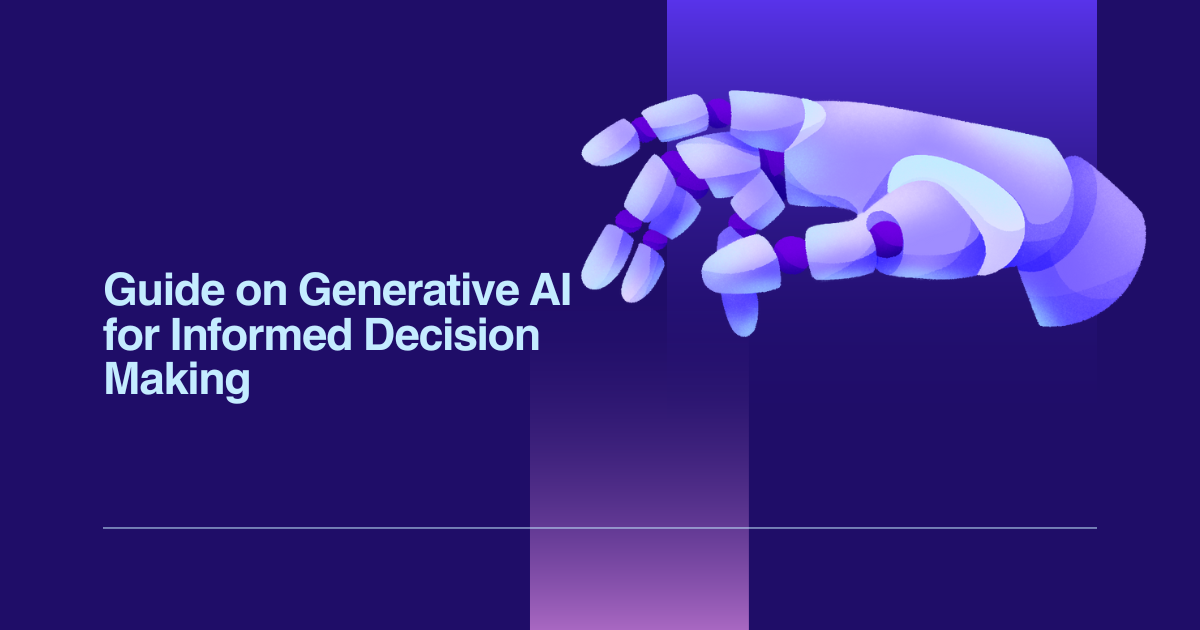Guide on Generative AI for Informed Decision Making
Studies show that over 60% of executives are already leveraging generative AI to support strategic decisions, and that number is rapidly growing. Decision-making is no longer based on intuition alone — it is becoming a data-powered discipline. At the center of this transformation is Generative AI Decision Making, a powerful approach where artificial intelligence not only analyzes information but also generates new insights, scenarios, and solutions. Whether you’re a business leader, data scientist, healthcare provider, or policymaker, understanding how to harness Generative AI Decision Making can significantly reshape the way you operate.
This comprehensive guide will walk you through what Generative AI is, how it works, and how it can be applied to make smarter, faster, and more strategic decisions across industries.
1. What Is Generative AI?
Generative AI refers to machine learning models that can generate new content — from text and images to code, music, simulations, and even synthetic data. Unlike traditional AI systems that focus on analysis and prediction, generative models like GPT (Generative Pre-trained Transformer) and GANs (Generative Adversarial Networks) are trained to create.
These systems learn from existing data and use it to produce original, high-quality outputs that resemble human-created content. This capability is a game-changer for decision-makers who need access to realistic simulations, diverse datasets, and rapid ideation.
2. How Generative AI Works
At its core, Generative AI uses deep learning models trained on massive datasets. Here’s a simplified look at how it functions:
- Input Data: The AI is trained using huge volumes of structured and unstructured data.
- Training Phase: Neural networks detect patterns, relationships, and context.
- Generation Phase: The model produces new content based on learned data — often so realistically that it’s hard to distinguish from human output.
Some well-known tools include:
- GPT models (like ChatGPT) for generating text
- DALL·E for images
- DeepMind’s AlphaCode for software development
- Synthesia for creating videos
3. Key Benefits of Generative AI in Decision Making
Why are organizations flocking to Generative AI for their decision-making needs? Because it provides:
- Faster insights from complex data
- Creative solutions in design and product development
- Automated content generation for marketing, reporting, and communications
- Cost-effective data augmentation for training and testing other AI models
- Realistic simulations for planning and forecasting
Ultimately, Generative AI helps leaders make informed decisions quickly, with confidence backed by real-time data and projections.
4. Use Cases Across Industries
Let’s explore how various sectors are leveraging Generative AI for smarter decision-making.
a. Healthcare
Generative AI can simulate clinical trials, generate synthetic patient data, and support diagnoses with detailed text generation on symptoms and treatments.
b. Finance
It enables fraud detection models, personalized customer communications, and scenario simulations for investment decisions.
c. Manufacturing
AI-generated designs and materials simulation help reduce prototyping costs and shorten time-to-market.
d. Marketing
Content generation, A/B testing predictions, and consumer behavior simulations are optimized with AI-generated insights.
e. Education
From personalized learning paths to auto-generated content for courses, education tech is evolving fast with generative tools.
5. Enhancing Strategic Planning with Generative AI
Strategic planning involves looking ahead — something generative AI excels at. By analyzing past data and generating multiple scenarios, AI tools:
- Identify risks and opportunities
- Forecast market trends
- Model different business strategies
- Offer real-time updates as variables change
This makes your strategy proactive rather than reactive.
6. Role in Business Intelligence (BI)
Business Intelligence (BI) tools traditionally rely on dashboards and historical reporting. When integrated with generative AI, BI platforms gain the ability to:
- Generate reports and summaries automatically
- Offer narrative explanations for data trends
- Simulate outcomes based on new variables
- Ask natural-language queries (e.g., “What happens if we cut costs by 15%?”)
This leads to more accessible, dynamic, and actionable intelligence for all decision-makers.
7. Risk Management and Predictive Analysis
Generative AI doesn’t just help with creative tasks — it’s also a powerhouse for risk management.
By generating simulations and stress tests, companies can see how different scenarios (market crashes, supply chain breakdowns, cyber threats) might play out. This makes contingency planning and risk mitigation far more robust and data-driven.
8. Ethics and Governance
As we adopt generative AI, ethical considerations are vital:
- Transparent algorithms
- Explainable AI decisions
- Fair access to AI tools
- Prevention of malicious use (deepfakes, synthetic fraud)
- Protection of user data and privacy
Companies should develop a strong AI governance framework to ensure responsible use.
9. Overcoming Challenges and Implementation
Despite the many benefits, implementing generative AI can come with hurdles — such as integration complexity, data readiness, and the need for skilled personnel. For this reason, many businesses choose to collaborate with a specialized generative ai development company to ensure smooth deployment, scalability, and domain-specific customization. The right partner can guide you from strategy to execution with minimal friction.
10. The Future of Decision-Making with Generative AI
We are only scratching the surface. Here’s what the future might look like:
- AI-powered board meetings where scenarios are auto-generated and visualized
- Personalized dashboards adapting in real time to user queries
- Synthetic simulations replacing costly trial runs
- Generative agents that plan, analyze, and report without human prompting
As these innovations mature, decision-making will become faster, more collaborative, and deeply data-driven.
Conclusion
Generative AI is redefining decision-making. No longer limited to analyzing what has already happened, this technology empowers organizations to simulate futures, explore possibilities, and act with confidence.
Whether you’re designing a new product, preparing for market changes, or responding to customer needs, Generative AI offers tools to elevate your decision-making process to new heights. But like all tools, its power lies in how you use it.

